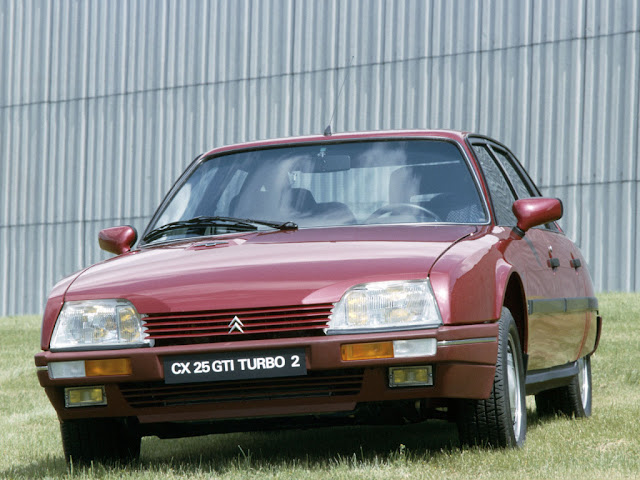The Citroën CX is an executive car produced by the French automaker Citroën from 1974 to 1991. Citroën sold nearly 1.2 million CXs during its 16 years of production. The CX was voted European Car of the Year in 1975. The CX's flowing lines and sharp Kamm tail were designed by auto stylist Robert Opron, drawing upon its precursor DS. The name CX is the French equivalent abbreviation of Cd for drag coefficient in English, drawing attention to the car's aerodynamic styling, which was uncommon in 1974. It is considered by some enthusiasts as the last "real Citroën" before Peugeot took control of the company in 1976. Available models were a four-door fastback, a station wagon (break, or estate car), and a long-wheelbase model built on the break chassis.
Mechanically, the car was one of the most modern of its time, combining Citroën's unique hydro-pneumaticintegral self-leveling suspension, speed-adjustable DIRAVI power steering (first introduced on the Citroën SM), and a uniquely effective interior design that did away with steering column stalks, allowing the driver to reach all controls while both hands remained on the steering wheel.
The "Normale", basic model, CX car came with a 1985cc version of the four cylinder engine with a claimed maximum output of 102 hp (76 kW). In 1984, turbo-powered 2.5 L diesel engine made the CX Turbo-D 2.5 the fastest diesel sedan in the world, able to reach speeds up to 195 km/h (121 mph). The 93 x 92 mm, 2,500 cc four-cylinder engine is equipped with a Garrett T3 turbocharger which boosts its output to a very respectable 168 bhp (DIN) at 5,000 rpm. The GTi Turbo gasoline model had a top speed of over 220 km/h (137 mph). In July 1985, the styling was revised, resulting in a model known as the Series 2. (wikipedia & motorsportmagazine.com)
CX 25 GTi Turbo 1 (1984-85)
Series 1 CXs were characterised by stainless steel front and rear bumpers, hydropneumatic suspension as compliant and soft as the DS. They also had a "spaceship" style dashboard featuring a revolving drum speedometer and similar tachometer, and a "stalk-free" layout where turn signals, wiper controls, horn and headlights could be operated by the driver's fingertips while his/her hands remained on the steering wheel. However, from a road test review of the Turbo 1 in 1984, the year the model was released, Turbo 1 had the more traditional Series 2 dial meters.
The turbo-powered 2.5 L diesel engine made the CX Turbo-D 2.5 the fastest diesel sedan in the world, able to reach speeds up to 195 km/h (121 mph). The GTi Turbo gasoline model had a top speed of over 220 km/h (137 mph). (wikipedia & oocities.org)
The turbo-powered 2.5 L diesel engine made the CX Turbo-D 2.5 the fastest diesel sedan in the world, able to reach speeds up to 195 km/h (121 mph). The GTi Turbo gasoline model had a top speed of over 220 km/h (137 mph). (wikipedia & oocities.org)
CX 25 GTi Turbo 2 (1986-89)
In July 1985, the styling of the CX was revised, resulting in a model known as the Series 2. The cars lost some of their earlier distinctiveness. The suspension became stiffer in most models. Plastic bumpers were the most notable exterior change, giving what some say is a more aggressive look, as opposed to the more elegant Series 1 design. Although the dashboard retained the "pod" housing for the instrumentation, it lost the revolving-drum instruments and received a sloping centre dash area, and the radio moved to a position sideways and between the front seats, with the height corrector and heating controls moving to the centre console. The 25 GTi Turbo 2 was introduced in 1986, with new intercooler and improved performance. All CX saloon models discontinued in 1989. Estate models continued until 1991. (wikipedia)
(Photos from flickr.com, ginacollectorcars.com, autowp.ru, mobile.de, classiccarsforsale.co.uk & car-from-uk.com)

























































































































